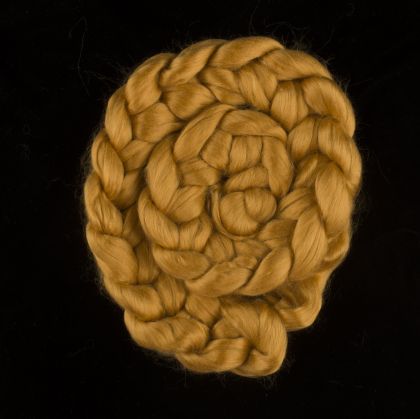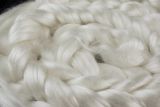Eri Silk (red) Combed Top/Sliver (A1 Grade) Wild Silk - 200g
Most forms of eri silk are white; however, Philosamia ricini silkworms raised in the Goalpara District of Assam, India (and a few other locations) are brick red.
Eri silk has less sericin (the protein ‘glue’ that protects the silk and holds the silk together in its cocoon shape) than other types of silk, so the eri cocoon has a fuzzy texture. Click here to see the cocoons
The natural red color is ‘fugitive,’ meaning the color will fade when exposed to the soaps and other ingredients used during degumming. Typically, the red color reverts to cream or beige during degumming.
Our red eri combed top/sliver has been dyed in India to match the color of the red eri cocoons. Click here for the background story.
We have wetted the red eri silk combed top/sliver in hot tap water for 24 hours and the red color is retained--it did not stain Bombyx/mulberry or natural (unbleached) Tussah silks in the same basin.
We repeated the experiement adding a touch of mild soap (e.g. original blue "Simple Dawn®") and the red color still stayed in tact, even when sharing the bath with white eri silk and natural tussah silk.
However, sharing a the bath with bleached tussah, different soaps, or hot water could affect the fnature of this dyed red color, so testing is highly recommended.
Our eri wild silk top has a 3.5 to 4 inch fiber length and is heavenly to touch. 13.5 to 17 microns
Treenway Silks has used the same silk supplier in India for over 20 years and he consistently delivers top quality.
200 Gram (7 oz) packages
Color: brick red dyed to match the red eri cocoons
Purchase $150 of 'bulk' undyed yarns or fibers and receive a 10% discount on those items. The discount will be applied manually (by a human-that's me!) before finalizing your pending credit card charge. A reminder is always appreciated—you can do that in “comments” in the final screen when checking out (step 5)
Silk handspun and handknitted by Diane de Souza
PEACE SILK? not really.
Silk is an eco-friendly product.
- Ahimsa silk is a patented term referring to an eco-friendly method of manufacturing spun mulberry silk
- Eri silk could be peace silk, but most likely it is not, as almost always the pupa is removed for feeding people or other animals
- Don't assume that because tussah, muga and eri silk are wild silks they are peace silks--muga and tussah are also reeled and the eri pupae are used for food--so check your sources.
- The only true peace silk is made from cocoons in which the pupa has matured into a moth. Most often this is for breeding purposes, and the quantity of this type of silk is very small.
- The caterpillars produced from the eggs resulting from all the matings from unstilfed cocoons (200 to 500 eggs per moth) would not have enough food and they would die from starvation and neglect.
- Sericulture is a sustainable, renewable, environmentally friendly resource that gives million of rural people a healthy, family-oriented lifestyle.






